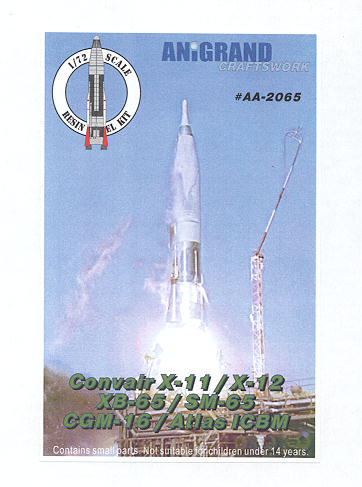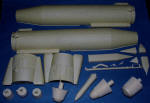
| KIT: | Anigrand 1/72 Convair Atlas ICBM |
| KIT #: | AA-2065 |
| PRICE: | $64.00 MSRP from Anigrand USA. Free US shipping |
| DECALS: | One option |
| REVIEWER: | Scott Van Aken |
| NOTES: | Resin kit. Does one of three options. |

| HISTORY |
A development contract for the Atlas was awarded to Convair in January 1955, and Convair completed construction of the test stands in 1956. Convair Division of General Dynamics Corporation conducted static test firings of an Atlas missile at its Sycamore Canyon test facility northeast of San Diego.
The Atlas A was the first R&D configuration that ultimately led to the operational Atlas D, E, and F missiles. It consisted of minimum propellant, propulsion, and guidance systems. Its maximum range was only 600 nautical miles, and its maximum altitude was 57.5 nautical miles. A total of eight Atlas As were launched--all on the Atlantic Missile Range--during the period June 1957 to June 1958. The B series was the second Atlas developmental configuration. Its propulsion system was close to operational capability, and one series B missile traveled 5,500 nautical miles down the Atlantic Missile Range. Atlas 4-B, the second in the series B test flights, was launched successfully on 2 August 1958. The eighth missile in the series, Atlas 10-B, placed itself into orbit with the Project SCORE payload on 18 December 1958, becoming the world’s first communications satellite in the first successful use of the Atlas as a space launch vehicle.
The Convair Division of General Dynamics produced three different models of the Atlas ICBM destined for deployment with the Strategic Air Command. The first operational version of the Atlas, the "D" model, was a one and one-half stage, liquid-fueled, rocket-powered (360,000 pounds of thrust) ICBM equipped with radio-inertial guidance and a nuclear warhead. It was stored in a horizontal position on a "soft" above-ground launcher, unprotected from the effects of nuclear blast, and had an effective range, like all Atlas models, of approximately 6,500 nautical miles. The second Atlas ICBM configuration, the series E, possessed all-inertial guidance, improved engines (389,000 pounds of thrust), a larger warhead, and was stored in a horizontal position in a "semi-hard" coffin-type launcher. The series "F" missile was superior to its predecessors in several ways. Like the E model, the Atlas F was equipped with all-inertial guidance, but possessed improved engines (390,000 pounds of thrust) and a quicker reaction time due to its storable liquid fuel. The Atlas F missiles also were deployed in "hard" silo-lift launchers which stored the missiles vertically in underground, blast-protected silos and used elevators to raise the missiles to ground level for launch.
Meanwhile, considerable progress was made in developing second-generation ICBMs such as the Minuteman. Among the numerous advantages the newer missiles had over the Atlas was their ability to be launched from hardened and widely dispersed underground silos. Minuteman was also more economical to operate, more reliable, and because of its silo-launch capability, better able to survive a nuclear first strike than their first-generation counterparts.
Consequently, on 24 May 1963, General Curtis E. LeMay, Air Force Chief of Staff, approved the recommendations of the Air Force Ad Hoc Group for phaseout of Atlas D by the end of FY 1965 and the Atlas E's by the end of FY 1967. On 16 May 1964, Secretary of Defense Robert S. McNamara accelerated the phase-out of the Series E Atlas from the end of FY 1968 to the close of FY 1965. In addition, Secretary McNamara ordered the retirement of all Atlas F ICBMs by the end of FY 1968.
Project "Added Effort", the Air Force nickname for the programmed phaseout of all first-generation IC8Ms, began on 1 May 1964 when the first Atlas D's were taken off alert at the 576th Strategic Missile Squadron, Vandenberg AFB, California. Project Added Effort reached completion on 20 April 1965 when the last (first-generation) ICBM, an Atlas F. was shipped from the 551st Strategic Missile Squadron, Lincoln AFB, Nebraska, to Norton AFB, California, where it and other retired Atlas ICBMs were stored for future use as launch vehicles in research and development programs.
The Atlas was referred to by a number of designations, especially during the early years of testing. X-11, X-12, XB-65, SM-65 and finally CGM-16 were all used to identify Atlas variants.
| THE KIT |
 To my knowledge, this is Anigrand's first kit of this kind and they've done a great job on it. The main body of the missile is cast in two very nice halves that in my case were nearly free of any mold defects. Only a small air bubble on an external line was found. The lower halves are the rocket nozzle section. There are three nozzles with the two outer ones being identical. These had a small amount of mold shift to contend with. For the sides of the missile there are varying lengths of fairing. The ones you use will be determined by the variant you decide to build. This will also determine the nose cone that is installed. The X-11/Atlas-A has the rounded tip, X-12/Atlas B has the flatter tip and the XB-65/SM-65/Atlas-D operational missile has the long probe-type tip that is shown on the box art. The kit also includes the large external line between the upper and lower sections and the small steering nozzles.
To my knowledge, this is Anigrand's first kit of this kind and they've done a great job on it. The main body of the missile is cast in two very nice halves that in my case were nearly free of any mold defects. Only a small air bubble on an external line was found. The lower halves are the rocket nozzle section. There are three nozzles with the two outer ones being identical. These had a small amount of mold shift to contend with. For the sides of the missile there are varying lengths of fairing. The ones you use will be determined by the variant you decide to build. This will also determine the nose cone that is installed. The X-11/Atlas-A has the rounded tip, X-12/Atlas B has the flatter tip and the XB-65/SM-65/Atlas-D operational missile has the long probe-type tip that is shown on the box art. The kit also includes the large external line between the upper and lower sections and the small steering nozzles.
The kit includes a pair of US insignia to fit along the side. No stand is included so you'll need to supply that. It might also be a good idea to put some weight in the lower section. Some of the resin pour stubs mate right up to the side of some finned areas so you'll need to be careful when cleaning these parts. It really can't be helped.
The instructions are typical Anigrand with an exploded view, history and parts list on one side with painting and markings guide on the other. Each of the different variants is clearly identified and the difference in parts and markings is provided. Another nice thing is no vacuformed canopies!!! Well, that is probably only important to me as I always have trouble with them.
| CONCLUSIONS |
This is really a great start and I know that there will be more missiles/rockets in future releases. Perhaps they will also do a Minuteman or Thor series. This kit should sell very well so I recommend you get yours soon.
September 2006
| REFERENCES |
Various Internet Web Sites. A google will get a lot of information.
Thanks to Anigrand USA for providing the review kit. Get yours from the link and get free US shipping.
If you would like your product reviewed fairly and fairly quickly by asite that has over 325,000 visitors a month, please contactme or see other details in the